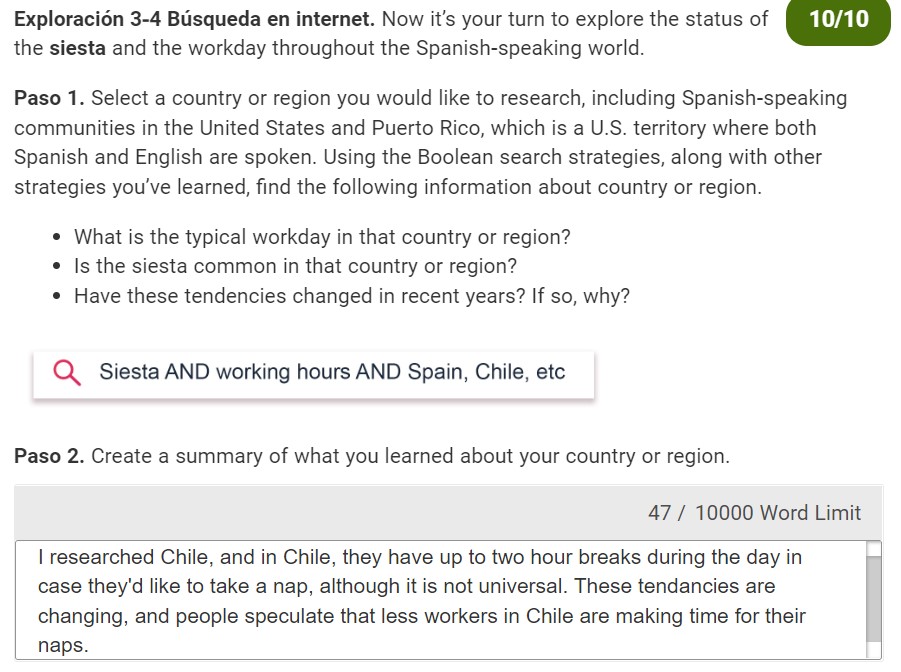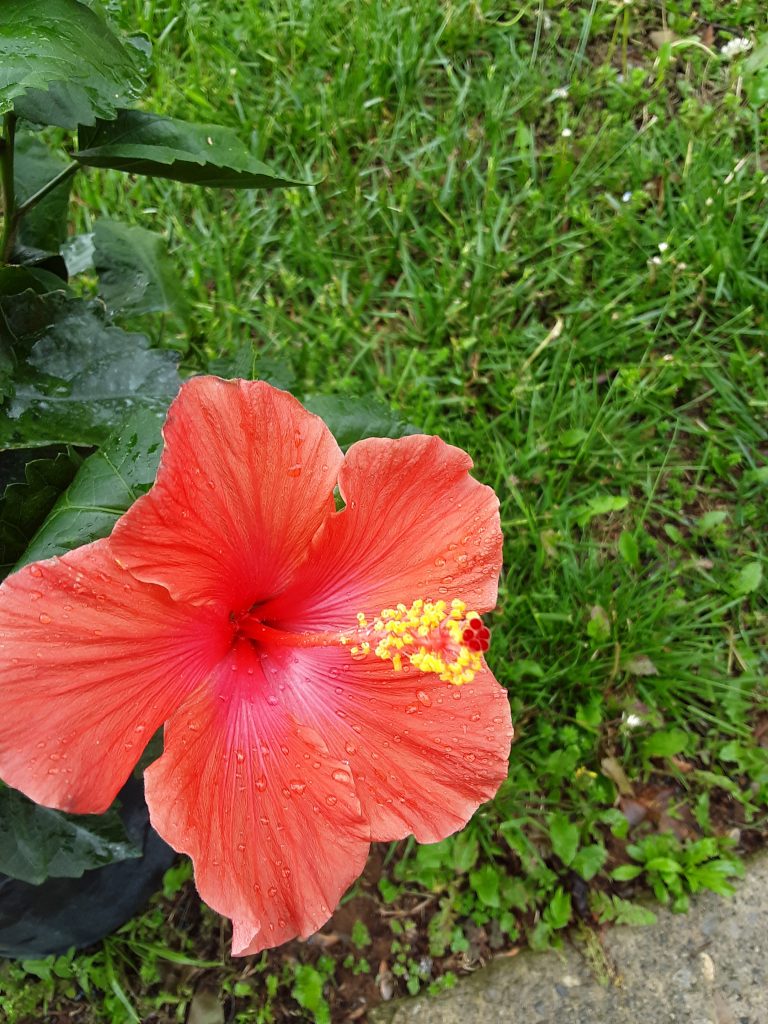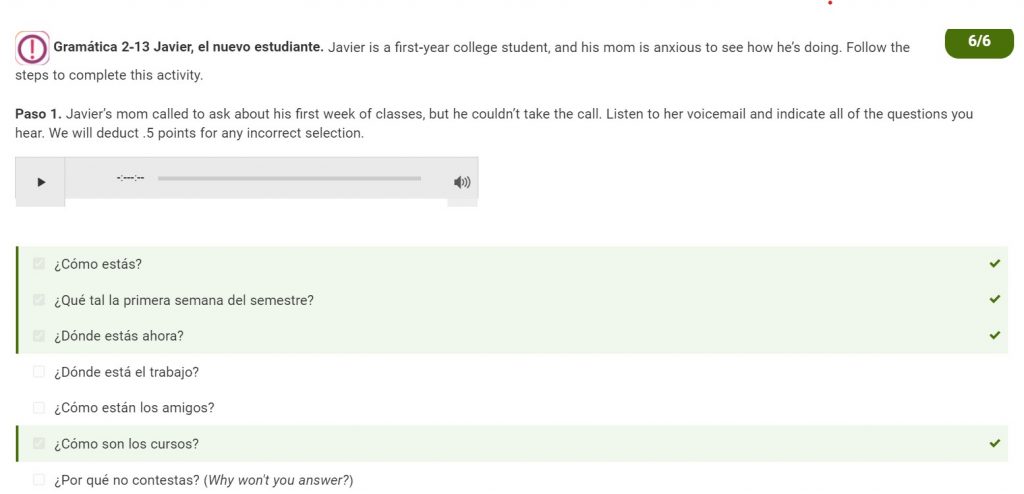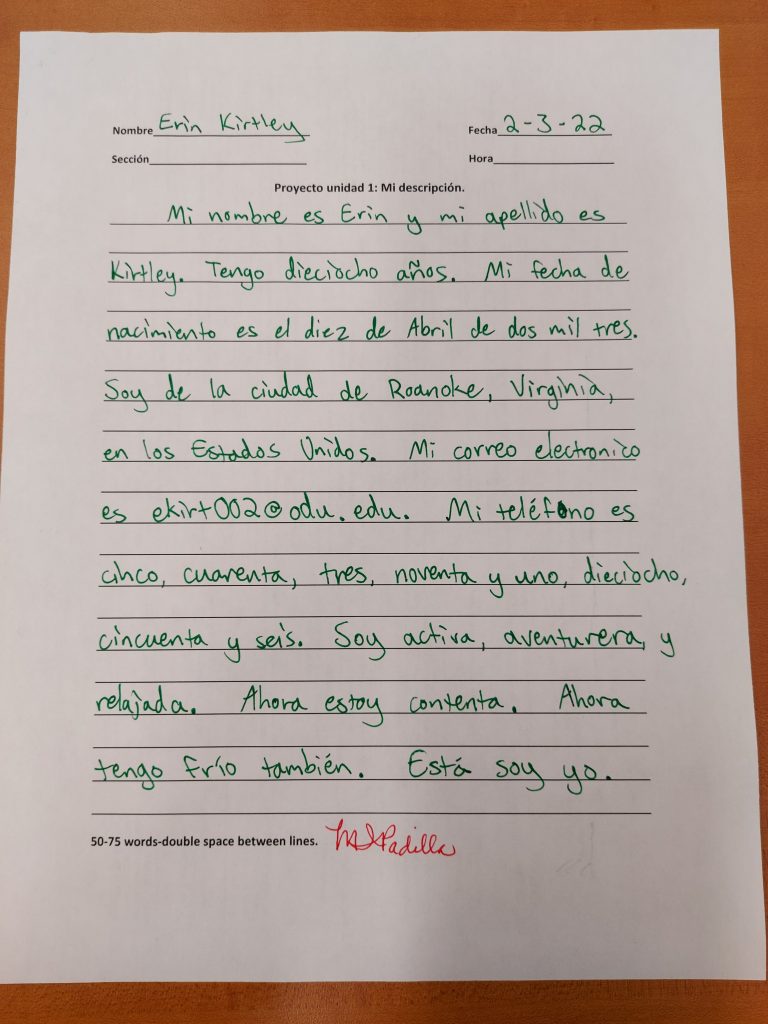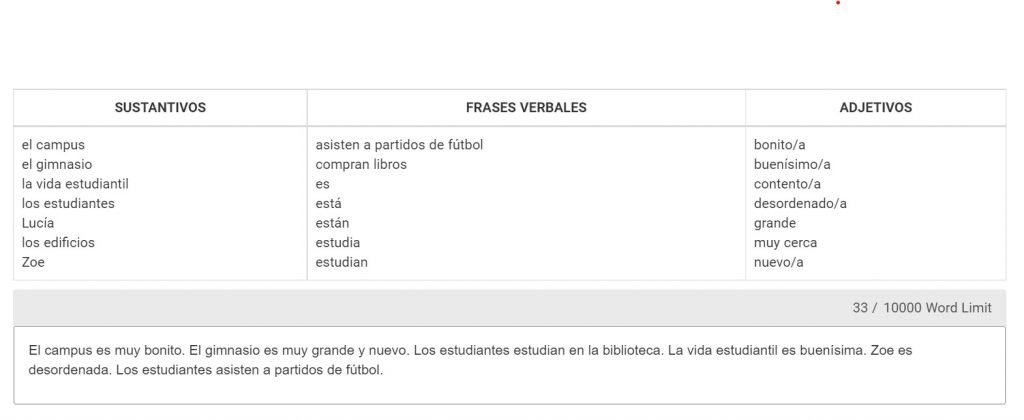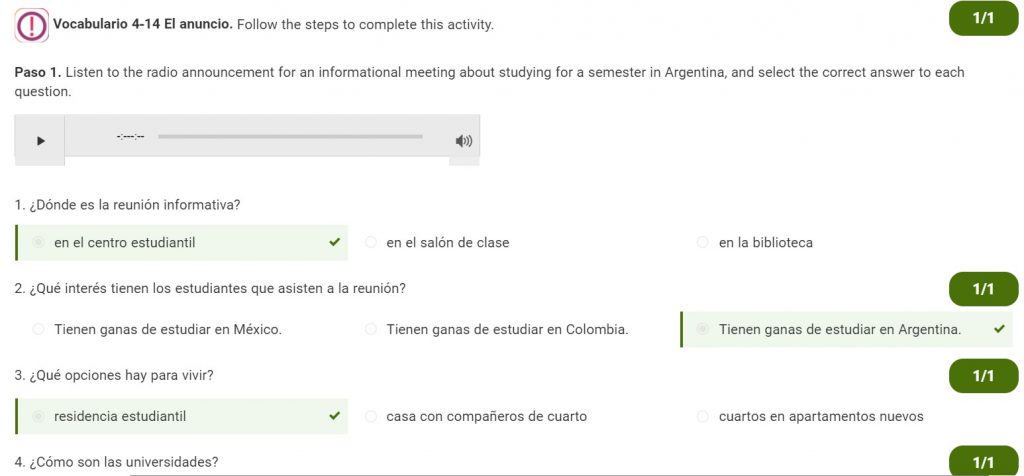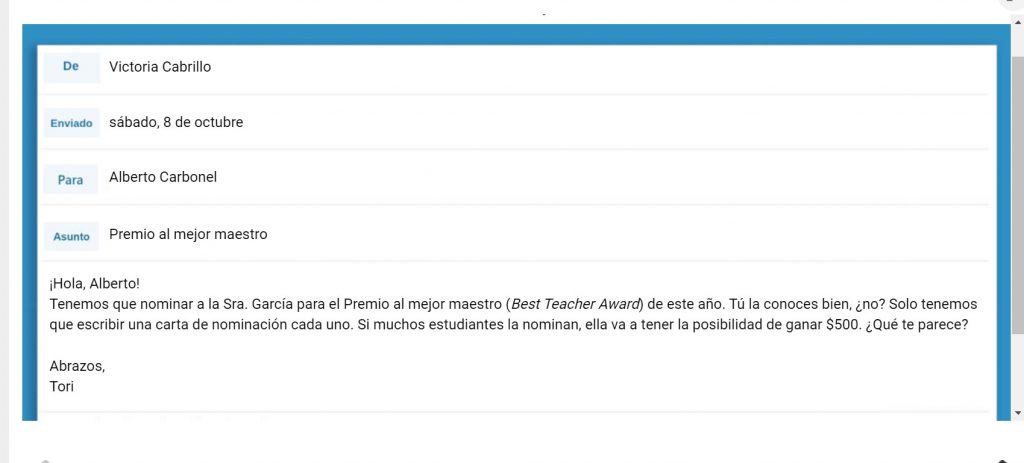Interpretive, Interpersonal, and Presentational Modes of Communication
Exploring Culture
Throughout this course, I have learned a lot about different cultural perspectives. In each chapter, there is a section titled “Exploración cultural,” where we would learn about the different aspects and practices of the different cultures. We were also given handouts, such as the handout titled “La Siesta,” which told us about different cultural practices that are important to day-to-day lives. In class, we would also have discussions about different cultural perspectives, such as one class we had in which we discussed the differences between universities in different countries. We have done a lot to explore and learn about different cultures.
These products and practices discussed in class helped me to better understand different values and practices in the Hispanic culture, and how they differentiate with the values I grew up with here. It helped me learn about my own values and practices as well by showing how others could have a different perspective on them. The cultural differences discussed in class changed my worldview because it helped me better understand unique ideas from other cultures and how each country is rooted in different values and beliefs. One reason why I really appreciate that we learned about different practices in the day-to-day lives of other cultures is because many people’s perspectives – mine included – are clouded by only thinking of the things we grew up with. For example, in America, taking a nap during the day if you have a full-time job is frowned upon, and you are seen as not very hard-working, whereas in some countries in Latin America, taking a nap during the day is normal and even encouraged. It is wonderful that these countries value the workers’ energy, and it has different effects on people’s health. Learning about the values of other cultures can be eye-opening, and it is important to see the world through more than just the perspective you grew up with.
Engaging in Communities
It is very important to engage in your community. Your community is your home, and it is important to take care of it. It is also just as important to engage in your global community to learn about other cultures and see things from different perspectives.
I participate in my community by being on the ODU drumline. In this community, I’ve been able to make connections that have changed my point of view. I also contribute to my community at home because I water plants and outdoor flowers for my house and for my neighbors. I love taking care of plants, and the natural world is in desperate need of preservation. Doing small things like this for my community is fun and it is a way that I help take care of the natural environment in my community.
Interpersonal Communication
During this course, I did a lot of interpersonal communication with my classmates, the professor, and the program online. We did a lot of speaking excercises in class where we would have a short conversation with our classmate or with the professor. For example, the professor would ask a question in Spanish, and we would each take turns answering in Spanish. In the online program, we would also do a lot of speaking, where we would record ourselves answering a prompt in Spanish and the professor would give us feedback in the comments. We would also do a lot of listening excercises in the online program by listening to a recording of someone speaking or asking a question, and we would type our answers in Spanish – the professor would also give us feedback on this so we can learn what we needed to improve on!
This practice of interpersonal communication has helped me greatly. It has helped me understand better how to speak and pronounce words, and how to listen in Spanish. There would be many unplanned communication activities in class, in which the professor would review a lesson by randomly asking each of us a question, and we would have to answer in Spanish. This helped us prepare by giving us a better understanding of how to listen for words that we had gone over. It also helped us study because we never knew when we would need to answer or ask a question in Spanish. In the listening and responding activities, I have learned better how to listen to the language and pick out the words that I know that can give me context clues to what the question or statement was. The speaking activites helped me to learn the vocabulary words and how to pronounce words better in Spanish. At first it was difficult to understand what was being said in the listening excercises, even when I knew all of the vocabulary words, just because I wasn’t used to the dialect. I overcame this struggle by watching movies and shows in Spanish with English subtitles! By listening to the script in Spanish while reading it in English, I was able to better understand the Spanish dialect, and it even helped me study for common vocabulary words. One thing I think I did better with was pronunciation, because I have worked with many Spanish-speakers and I was able to pick up on how certain letters or syllables sound different in Spanish than they do in English. I have learned a lot from the interpersonal communication part of this course, and while it wasn’t entirely easy, it has definitely gotten easier with time and a lot of practicing with my bilingual friends!
Presentational Speaking
Throughout this course, I have completed a few presentational speaking activities that helped me get used to speaking Spanish. I have written a description of myself in Spanish, interviewed someone who’s first language was Spanish, and I have created a video of myself presenting a tour of my university in Spanish.
In order to write this paper, I studied all of my vocabulary words from the first and second chapters on flashcards. I practiced with the flashcards with my friends and my roommate. It took a lot of studying, but I am ultimately proud of the result. I can see how much more I’ve learned since I wrote this paper.
One thing I think I exceled at was the vocabulary because I studied a lot for it. I would keep my flashcards on my desk and during any free time I had I would flip through them and study. Grammar was one area that I struggled in and I still struggle with it now. I have a lot of practice to do, but I can tell that I am getting better than where I started!
Presentational Writing
I have written many Spanish compositions for this class, and it has definitely helped me learn how to better write in Spanish. The online course, Contraseña, includes a lot of writing activities and compositions.
In the prompts and activities given by Contraseña, I learned how to put sentences together in Spanish and how to make a grammatically correct sentence. The in-class compositions also taught me how to utilize the vocabulary words we had learned and how to make a well-written short essay in Spanish. These assignments really helped me understand the language more because I was able to see my thoughts translated onto the paper. I was also able to take the feedback given to me by my professor and improve. Understanding the language became easier once I started learning how to write it, because it helped me understand speech patterns and recognize parts of speech, such as adjectives, nouns, or verbs. I have struggled trying to understand the gramatical rules of the language, but with practice in writing and speaking it, I feel I have definitely improved. Next semester, when I continue with Spanish II, I will practice more with the optional writing assignments in the online program, and study the grammar rules more. Practice is the best way for me to study.
Interpretive Listening
Throughout this semester, we have done a lot of interpretive listening activities to help us better understand Spanish. The online course on Contraseña has given us a lot of excercises in which we listen to a recording of someone speaking in Spanish and we have to either respond coherently or loosely translate it. We also have spent a lot of time listening to our professor speak Spanish and us responding to her.
Excercises like this were challenging at first because it was hard getting used to hearing the language being spoken at a regular speed and understanding it. I had to listen to the recording several times in order to answer the questions all correctly. With practice listening to it in class and on Contraseña, I have gotten a lot better at listening and comprehending Spanish. What I have taken away from the listening activities in this class is that I am now better at understanding Spanish when it is spoken to me, and it has also helped me learn the grammar rules of Spanish, because I have gotten to hear them spoken to me. With each activity, I have learned more and more vocabulary words as well. Hearing the language spoken helps engrain the meanings of vocabulary words in my head, as well as grammar rules.
Interpretive Reading
Throughout this semester I have done a lot of interpretive reading. In class we did a lot of interpretive reading together so that the professor could help us if we needed it. In the online course, Contraseña, we also did a lot of reading individually so that we could learn to understand it on our own and use context clues and our vocabulary notes. We read websites for universities in Latin America, emails from people who speak Spanish on Contraseña, and short paragraphs written in Spanish by people explaining different aspects of their cultures.
With interpretive reading assignments such as these, I have learned many new vocabulary words and I have gotten better at understanding the language when it is spoken to me because I have learned what it looks like on paper. I am a very visual learner, so excercises like this definitely helped me better understand the listening sections, because I got to see some of the vocabulary words and grammar on paper before listening to it.
The interpretive reading we did in class with the professor also helped a lot because we were all working through the same problems together, and we could help each other out if we didn’t understand something. We also had the professor there for us if we had any questions. By doing interpretive reading excercises, I have learned a lot more about the grammar and vocabulary of Spanish, and it has helped me a lot in the writing portion of the course as well as the listening and comprehension assignments.
